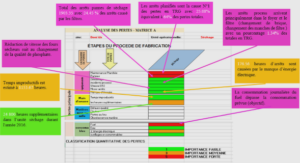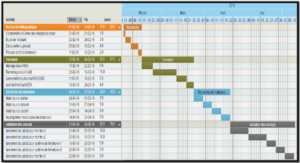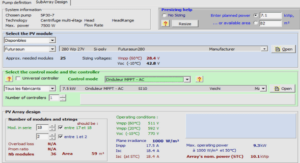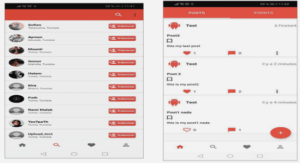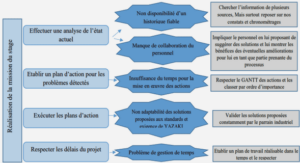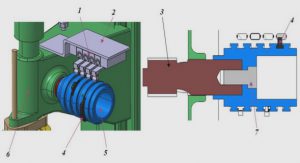Télécharger le fichier pdf d’un mémoire de fin d’études
Separated radiators
In order to realize multiple functions, the intuitive solution is to juxtapose several antennas, each optimized and working independently for a specific function [12] – [15]. In general, the considered radiators work in different frequencies, share the same support but are fed separately. This solution will be called separated radiators in this chapter. However, taking into account directivity constraints for one or more functions will straightforwardly cause significant increase in the space occupied by the antennas. Thus, the trend is to place the antennas as close as possible to reduce the space they occupy. In this case, it would be necessary to take into account the eventual mutual coupling between the antennas.
As an example, Figure 1.1 depicts an integrated vehicular antenna for global positioning system (GPS), remote keyless entry system (RKES) and personal communication system (PCS) [14]. As can be seen, the two antennas share the same substrate each with its own feeding port. The isolation obtained between the two ports is at least 20 dB from 0.2 GHz to 2.2 GHz. However, as already explained, for applications requiring more directivity it would be necessary to increase the size of the antennas and therefore that of the support. Moreover, the use of separated radiators requires different feeding ports to route the signals, reducing the system compactness.
The next section will deal with multifunction antennas techniques.
Multifunction techniques
Traditionally, there are two approaches to achieve multifunctionality: time sharing [2] (time domain or time multiplexing), and aperture sharing [2] (space domain or aperture segmentation). This section presents the principle of the two approaches and some examples.
Time sharing
Time sharing technique, compatible with any type of antenna, consists in sharing the antenna resources alternatively with different systems at distinct time slots. Figure 1.2 depicts the use of this technique for n functions. As can be seen from this figure, when function 1 is needed, the switch allows the use of its modem, while others are completely disabled and so on for each function. Moreover, this solution requires at least two feeding networks (according to the number of functions sharing the antenna) resulting in bulky system.
Since the applications are accomplished sequentially, in the case of radar and communication applications, the radar performance is affected each time a communication is needed [2]. Thus, the time sharing technique is not that good for radar and communication integration.
Figure 1. 2: Time sharing technique
With the recent technological developments, the current trend on this type of solution is to try to go even further by sharing more than the antenna (the RF front-end) [1]-[4]. Hence, the antenna, transmitter and receiver are reused by different radio systems. As already explained, for this thesis we will focus on solution consisting in modifying the antenna characteristics to achieve multiple functions.
In the next section, the shared aperture technique used to achieve multifunction capabilities will be presented.
Shared aperture
Shared aperture antennas are new type of antennas that regroup the functionality of several antennas into one aperture [8] [9] [10]. Then, the antenna aperture can be shared amongst many different radio applications such as communications, electronic warfare, or radar systems. As already explained, since the space available for the integration of antennas is limited in mobile phones, cars, residential access gateways, etc., the radiators must be carefully selected and designed to take into account this constraint.
According to the radiation characteristics of the shared aperture antenna, more precisely the directions considered (radiation pattern main beam) for the different RF applications, this solution can be divided in two categories: either the applications are realized in the same direction or they use different directions.
In the sections to come, we will present the particularities of each of the cases presented by giving some examples.
Same direction
In the present case, the applications are realized in the same direction. In order to ensure a good isolation between the different required applications, polarization diversity or frequency diversity are usually used [16].
• Polarization diversity
The polarization diversity approach consists of assigning to an antenna system the possibility to use orthogonal polarizations without physical separations in the antenna. The concept is based on the fact that in scattering environment, two orthogonal polarizations provide uncorrelated signals.
In [5], polarization diversity is used to achieve 45 dB isolation over a 20% band for a LFM radar with communication capabilities (cf. Figure 1.3). The used antenna is a microstrip pacth antenna working in S-band. The horizontal polarization is used for the communication function while the vertical polarization is dedicated to radar operation. To achieve the multifunction capabilities, the antenna uses two different feeding ports to route the different signals to the antenna reducing the compactness of the system. However, to improve the directivity, 1×4 antenna array is used, increasing the overall size of the antenna.
• Frequency diversity
The frequency diversity technique, often employed in microwave line of sight links, consists in transmitting or receiving simultaneously an information signal on two or more independently carrier frequencies (channels).
With the rapid development of wireless communication technology, this technique is more and more used [13] [17] [18]. This is frequently encountered in modern mobile communication systems where wideband radiating elements are used allowing to subdivide the total bandwidth into sub-bands used for each function [17] [18]. Hence, several applications such as GSM 900/1800 working between (824 MHz- 960 MHz) and (1.71 GHz – 1.92 GHz), 3G and 4G operating respectively between (1.8 GHz – 2.17 GHz) and (2.3 GHz – 2.69 GHz) can coexist.
In literature, many antenna systems combine frequency and polarization diversity [8] [19] for enhanced isolation between the various radio applications. In [19] for example, a stacked array structure providing continuous operation in S and X bands is designed. The array is a combination of a large rectangular ring-resonator antenna for S-band (2 elements) and circular patches for X-band (32 elements) and is dedicated to wireless communication, radar, remote sensing, and surveillance applications. Each of the arrays is fed by two ports to obtained horizontal and vertical polarizations. Hence the overall antenna is feed through four ports. The isolation between X and S bands are better than 25 dB.
Figure 1. 4: Dual beam receive array [9]
Different directions
In this part we investigate the possibility to realize the applications in different directions. Indeed, the use of different directions to achieve a multifunction antenna leads to the concept of multibeam antennas. A multibeam antenna is usually an array where the N elements are combined in several different ways, so as to produce M radiations [7] [8] [9] [11]. Considering the number of ports (input or ouput) of the antenna, the multibeam antennas can be divided into two categories: standard multibeam antennas using multiple ports [8] [9] [11] and multibeam antenna using a single port [7].
• Multibeam antenna with multiple ports
An example of multibeam antenna with multiple ports is depicted in Figure 1.4. This antenna is used in receive mode and can receive communication signals from two different directions through the use of two beamforming networks and two reception ports [9]. The array is composed of 8×8 dual polarized elements (Vivaldi) and works between 7 GHz and 10 GHz.
Figure 1. 5: SIW multibeam antenna [11]
In Figure 1.5, a substrate integrated waveguide (SIW) is used as a beamforming network, with four input ports and one output port, directly connected to the radiator [11]. Hence, four different beams can be obtained in different directions. The antenna works from 31 GHz to 36 GHz
Multibeam antennas can also take the advantages of polarization and frequency diversitiy techniques (presented in section 1.2.3.1), depending on the targeted applications. In [6], a slotted , waveguide with slots milled into opposite walls is used to provide a high-gain solution for two signals with orthogonal polarizations and working at two different frequencies (S-band for radar and C-band for communication).
However, as already explained, the use of multiple ports to route the different function signals to the radiating structure, may be seen as a drawback regarding the overall compactness. The next point will deal with the possibility of using a single feeding port with the aim of reducing the compactness of the system.
• Multibeam antenna with single port
The use of a single access port for a multibeam antenna is intended to make the antenna more compact. However, when applied to multifunction antennas, it is necessary to be able to modify the signal initially dedicated to one of the functions so that to include the signal of the other functions. This then introduces the notion of direct antenna modulation [21]-[24].
Direct antenna modulation is an attractive solution to generate RF data modulation for information transmission (or phased array beamforming) from a transmitting (receiving) antenna driven by a single unmodulated carrier. The unmodulated signal is transmitted in one direction while a part of this signal is modulated and transmitted in another direction. In contrast to conventional modulation, direct antenna modulation does not need a conventional modulator or variable RF phase shifter devices. Furthermore, as the phase and magnitude of the modulated fields are radiated coherently in desired directions only, this can provide a very discrete communication link, which is highly relevant when combined with a radar application.
Figure 1. 6: 16 elements array for TMA [7]
In [7], J. Euzière took benefit of the Time Modulated Array (TMA) technique [25] and direct antenna modulation to combine a radar function and a secondary communication function. The used antenna is a 16-monopole array originally dedicated to radar operation (cf. Figure 1.6). The possibility to vary instantaneously the sidelobes of the radiation pattern is used to transmit additional information in another direction. Hence, by conveniently switching the active dipoles while keeping the main lobe unchanged (preserving the radar function), a low data-rate communication could be established in desired directions.
After presenting the different multifunction antennas used in literature, in the next section, a classification of the set solutions presented in is chapter will be done.
Multifunction antennas classification
Figure 1. 7: proposed multifunction antennas (based on antenna architecture) classification
To facilitate the understanding of the operating principle of multifunction antennas and how they are designed, we propose a classification of the solutions (based on antenna architecture) presented in this chapter.
Figure 1.7 depicts the classification of the multifunction antennas solution. As presented before, in the present context, we will focus on solution offering simultaneous operation and based on antenna architecture. Hence, shared aperture takes advantage of time sharing. After the choice of the antenna structure (here shared aperture), now comes the choice of the directions in which we want to perform the set of functions. As presented before, this choice depends on the type of applications considered. Hence, in the case where the applications are needed in the same directions, polarization and frequency diversity can be used to enhance the isolation between the functions. Note that it is also possible to combine the polarization and frequency diversity techniques to multibeam antennas (different directions), cf. Table 1.1. However, for the applications performed in different directions, the space diversity offers an additional degree of freedom to reduce the mutual coupling between the considered functions. Concerning the multibeam antenna systems, they can be either powered by a single port or by multiple ports. The advantage of using a single port is the reduction of the size of the overall system. Furthermore, this offers the possibility to perform a direct antenna modulation without the need of complex electronic as for conventional modulation systems (cf. Table 1.1).
Conclusion
In this first chapter, a brief state of the art on multifunction antennas techniques has been presented. Based on the techniques presented in this chapter, two categories are distinguished: time sharing and aperture sharing. For integrated radar and communication applications, the downside in the former technique is that the functions are accomplished sequentially. The later approach makes it possible to perform the functions simultaneously, but also to control independently the radiation pattern (direction, polarization, frequency, etc.) required for each of the functions by focusing on the antenna architecture. Moreover, the compactness of the system can be further reduced by using a single input port and by realizing a direct modulation at the antenna level.
The first objective of this thesis being to take into account the space constraints of multifunction antennas, we will consider aperture sharing technique, using a single aperture, allowing to perform the functions simultaneously and to control the radiation pattern at antenna level. Furthermore, the possibility to integrate a direct modulation for the communication at the antenna level will be considered, offering a discrete communication link and reducing the compactness of the overall system by the use of a single feeding port. Hence, contrary to the work of J. Euzière [7] based on antenna array, this thesis will focus on the study of a single antenna that will be presented in the next chapter. Generally, for multifunction antennas, separated antennas are considered in transmission and reception. Thus, the proposed antenna system will only work in transmit mode.
|
Table des matières
INTRODUCTION
CHAPTER 1: STATE OF THE ART ON MULTIFUNCTION ANTENNA
1.1. INTRODUCTION
1.2. SEPARATED RADIATORS
1.3. MULTIFUNCTION TECHNIQUES
1.3.1. TIME SHARING
1.3.2. SHARED APERTURE
1.3.2.1. Same direction
1.3.2.2. Different directions
1.4. MULTIFUNCTION ANTENNAS CLASSIFICATION
1.5. CONCLUSION OF CHAPTER 1
CHAPTER 2: THE MULTIFUNCTION ANTENNA SYSTEM
2.1. INTRODUCTION
2.2. REDUCTION OF SLL
2.2.1. SLOT DESIGN
2.2.1.1. Parametric study on slot dimensions and position
2.2.2. IMPACT OF THE LARGE SLOT ON THE HORN RADIATION OVER THE STUDIED BAND
2.2.3. SLOT SHORT CIRCUIT
2.2.4. CONCLUSION
2.3. SLOTTED WAVEGUIDE (TRAVELLING WAVE MODE)
2.3.1. GENERAL OVERVIEW
2.3.2. SLOTS IN WAVEGUIDE BROAD WALL
2.3.2.1. Slot design in the waveguide
2.3.3. CONCLUSION
2.4. THE MULTIFUNCTION ANTENNA
2.4.1. ANTENNA SYSTEM
2.4.2. ANTENNA DESIGN
2.4.2.1. Slot design
2.4.2.2. BPSK direct modulation
2.4.3. ANTENNA PERFORMANCES
2.4.3.1. The main radar function
2.4.3.2. Communication function
2.4.3.3. Study of radar and communications isolation
2.5. CONCLUSION OF CHAPTER 2
CHAPTER 3: EXTENSIONS OF THE MULTIFUNCTION ANTENNA CONCEPT
3.1. INTRODUCTION
3.2. MULTIFUNCTION ANTENNA WITH FOUR COMMUNICATION DIRECTIONS
3.2.1. ANTENNA SYSTEM
3.2.2. ANTENNA DESIGN
3.2.3. ANTENNA PERFORMANCES
3.2.3.1. The main radar function
3.2.3.2. BPSK communication
3.2.4. CONCLUSION
3.2. SLOT ARRAY IN THE WAVEGUIDE
3.2.1. ANTENNA DESIGN
3.2.2. ANTENNA PERFORMANCE
3.2.2.1. The main radar function
3.2.2.2. Communication function
3.2.2.3. Study of radar and communication isolation
3.2.3. CONCLUSION
3.3. QPSK MODULATION
3.3.1. ANTENNA DESIGN
3.3.2. ANTENNA PERFORMANCE
3.3.2.1. The main radar function
3.3.2.2. Communication function
3.3.2.3. Study of radar and Communication rejections
3.3.3. CONCLUSION
3.4. CONCLUSION OF CHAPTER 3
CHAPTER 4: EXPERIMENTAL VALIDATION OF THE MULTIFUNCTION ANTENNA SYSTEM
4.1. INTRODUCTION
4.2. ANTENNA PROTOTYPE AND MEASUREMENT CHAMBER
4.2.1 ANTENNA PROTOTYPE
4.2.2. MEASUREMENT CHAMBER
4.3. COMPARISON OF SIMULATED AND MEASURED RESULTS
4.3.1. REFLECTION COEFFICIENT
4.3.2. RADIATION CHARACTERISTICS
4.3.3. THE MULTIFUNCTION ANTENNA
4.3.4. CONCLUSION
4.4. SWITCHING MECHANISM CONCEPT
4.4.1. BEAM LEAD DIODE
4.4.1.1. Ideal switches
4.4.1.2. Diode polarization circuit
4.4.2. IMPLEMENTATION USING PACKAGED PIN DIODE
4.4.3. CONCLUSION
4.5. CONCLUSION OF CHAPTER 4
CHAPTER 5: MULTIFUNCTION ANTENNA CONSISTING OF SIW HORN
5.1. INTRODUCTION
5.2. SIW TECHNOLOGY
5.2.1. GENERAL OVERVIEW
5.2.2. SIW HORN ANTENNA
5.3. THIN SIW HORN ANTENNA
5.3.1. SIW DESIGN
5.3.2. SIW HORN DESIGN
5.3.2.1. SIW horn with parallel plates
5.3.2.2. Slot design in the SIW
5.3.3. PERFORMANCE OF THE ANTENNA SYSTEM
5.3.4. SIW STACKED ARRAY
5.3.5. CONCLUSION
5.4. THICK SIW HORN ANTENNA
5.4.1. SIW DESIGN
5.4.2. SIW HORN DESIGN
5.4.2.1. Slot design in the SIW
5.4.2.2. SIW horn with dielectric extension
5.4.3. ANTENNA PERFORMANCES
5.4.4. SLOT ARRAY IN THE SIW
5.4.4.1. Antenna design
5.4.4.2. Antenna performance
5.4.5. CONCLUSION
5.5. CONCLUSION OF CHAPTER 5
CONCLUSION AND PERSPECTIVES
CONCLUSION
PERSPECTIVES
APPENDICES
Télécharger le rapport complet

